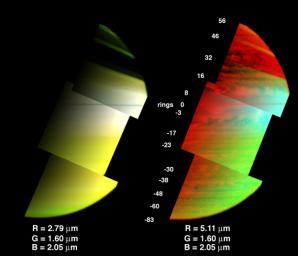
|
A 3-D View of Saturn’s Clouds and Hazes
- Click the image above for a larger view
- Full-Res JPEG (1052 x 903) (56.2 kB)
- Full-Res TIFF (1052 x 903) (2.9 MB)
Caption:
Saturn's clouds and hazes at three different levels in the atmosphere are depicted in the image on the right, as observed by the visual infrared mapping spectrometer on the Cassini spacecraft.
In the image, red represents the deepest clouds yet found on Saturn. They are at an altitude where pressure is nearly double Earth's sea-level air pressure. The spectrometer saw these clouds using a 5.1 micron wavelength. Brightness levels in the original image were inverted to show cloud as bright features. Green is an image taken simultaneously at 1.6 micron wavelength, showing upper-level clouds near and above the altitude where atmospheric pressure equals Earth's sea-level air pressure, a pressure expressed as 1 bar. Blue is an image taken at 2.05 micron, a wavelength which is limited to showing only higher cloud level due to absorption of light by the hydrogen gas comprising the bulk of Saturn's atmosphere. Blue indicated clouds of an altitude where atmospheric pressure is only about 70 percent of Earth's sea-level air pressure. Thus, the aqua-colored feature over the equator is high-altitude haze residing 10 kilometers (6 miles) altitude above the typical zonal features seen in reflected sunlight over the planet (green).
The image on the left shows only the upperatmosphere above the 1-bar level, and is the view seen in reflected sunlight as observed by cameras not capable of seeing the thermal radiation of Saturn. Red in this image was taken at 2.79 micron, a wavelength that absorbs ammonia. The greenish appearance of the south pole indicates that ammonia gas is enhanced there.
As opposed to the uniform bands of hazes and clouds seen over the planet at pressures near and less than 1 bar, clouds at the 2-bar level (red, in right-hand image) are distinct, and come in a variety of shapes and sizes.
These images were acquired by Cassini's visual infrared mapping spectrometer on June 28, 2005, from a distance of 1.2 million kilometers (745,645 miles), and at a solar phase angle of 102 degrees.
Background Info:
The Cassini-Huygens mission is a cooperative project of NASA, the European Space Agency and the Italian Space Agency. The Jet Propulsion Laboratory, a division of the California Institute of Technology in Pasadena, manages the mission for NASA's Science Mission Directorate, Washington, D.C. The Cassini orbiter was designed, developed and assembled at JPL. The visual and infrared mapping spectrometer team is based at the University of Arizona.
For more information about the Cassini-Huygens mission http://saturn.jpl.nasa.gov . The visual and infrared mapping spectrometer team homepage is at http://wwwvims.lpl.arizona.edu .
Cataloging Keywords:
| Name | Value | Additional Values |
|---|---|---|
| Target | Saturn | |
| System | Saturn | |
| Target Type | Planet | |
| Mission | Cassini-Huygens | |
| Instrument Host | Cassini Orbiter | |
| Host Type | Orbiter | |
| Instrument | Visual and Infrared Mapping Spectrometer (VIMS) | |
| Detector | ||
| Extra Keywords | Ammonia, Atmosphere, Color, Haze, Infrared, Thermal | |
| Acquisition Date | ||
| Release Date | 2005-09-05 | |
| Date in Caption | 2005-06-28 | |
| Image Credit | NASA/JPL/University of Arizona | |
| Source | photojournal.jpl.nasa.gov/catalog/PIA03559 | |
| Identifier | PIA03559 | |
